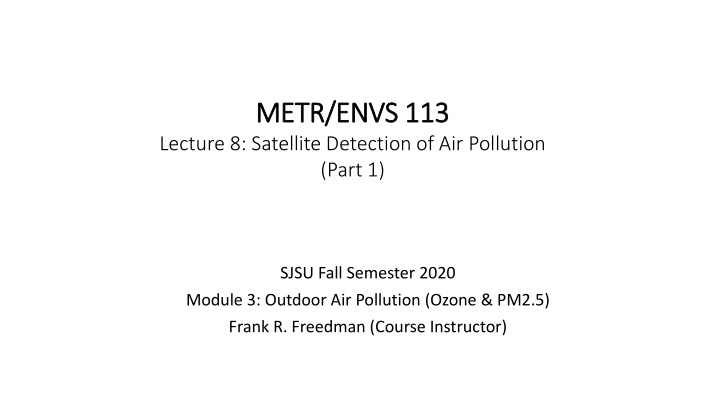
Satellite Detection of Air Pollution
Explore the use of satellites to detect air pollution in detail, covering topics such as measuring pollutants where no monitors exist, hourly tracking of wildfires, daily tracking of wildfire smoke, and locating urban emission centers. Learn about different types of satellites, including geostationary and polar orbiting, and how they provide continuous global coverage. Discover the various ways satellites measure air pollution using visible sunlight and infrared radiation, enabling the monitoring of pollutants such as nitrogen dioxide and aerosols.
Download Presentation

Please find below an Image/Link to download the presentation.
The content on the website is provided AS IS for your information and personal use only. It may not be sold, licensed, or shared on other websites without obtaining consent from the author. If you encounter any issues during the download, it is possible that the publisher has removed the file from their server.
You are allowed to download the files provided on this website for personal or commercial use, subject to the condition that they are used lawfully. All files are the property of their respective owners.
The content on the website is provided AS IS for your information and personal use only. It may not be sold, licensed, or shared on other websites without obtaining consent from the author.
E N D
Presentation Transcript
METR/ENVS 113 METR/ENVS 113 Lecture 8: Satellite Detection of Air Pollution (Part 1) SJSU Fall Semester 2020 Module 3: Outdoor Air Pollution (Ozone & PM2.5) Frank R. Freedman (Course Instructor)
Outline Background: Satellite Measurement of Air Pollution (Part 1) Motivation: Broader Spatial Coverage Geostationary vs. Polar Orbiting Visible vs. Infrared Total column abundance Demonstration (Part 2) Hourly tracking of wildfire PM2.5 & fires in California (GOES-17 & Suomi) Daily tracking of wildfire smoke across U.S. via carbon monoxide (Sentinel-5p) Locating major urban emission centers via nitrogen dioxide (Sentinel-5p)
Background: Main advantage of satellite measurements Continuous global coverage: See pollutants where no monitors exist Nitrogen Dioxide over the Eastern U.S. Aerosol Optical Depth (AOD): South & East Asia 3
Background: Different types of satellites Geostationary Fixed in place relative to rotating earth Continuous coverage in time (hour by hour) Geostationary Operational Environmental Satellite 16 (GOES-16): Eastern U.S. Geostationary Operational Environmental Satellite 17 (GOES-17): Western U.S. Sun Synchronous ( Polar Orbiting ) Orbits around the earth s poles Passes over a place on earth once a day (usually around mid-day) Daily snapshots (at around mid-day) Several different satellites (e.g. Suomi, Sentinel-5P)
Global Suite of Environmental Monitoring Satellites Note: Not current several more recent launches and replacements of those shown above
Background: Ways satellites measure air pollution Visible sunlight Visible sunlight reflected back to satellite sensor Examples: Smoke, Dust, Urban/industrial PM2.5, nitrogen dioxide (NO2) Infrared radiation Infrared radiation ( heat ) emissions by gases to satellite sensor Example: Carbon Monoxide (CO) For both, satellite measures total column abundance Total amount of air pollutant in column from surface to top of atmosphere. Commonly as aerosol optical depth (AOD) for aerosols (smoke, dust, PM2.5) Commonly as # of molecules per surface area for gases (NO2, CO)
Visible top of atmosphere (~ 500 km) Example column of atmosphere, extending from surface to top of atmosphere Satellite measures amount of sunlight reflected back to satellite sensor by atmospheric constituents within the column. The amount and wavelengths of radiation received by satellite will change according to how much of the measured air pollutant is in the column.
Infrared top of atmosphere (~ 500 km) Infrared radiation emissions from atmospheric gases Satellite measures amount of infrared radiation from earth to space detected by the satellite sensor. This amount will increase as the amount of pollutant gas is larger in the column. Satellite detection must be set according to the specific wavelength emitted by gas (e.g. around 2300 nm for CO)
Total Column Abundance top of atmosphere (~ 500 km) Example: Nitrogen Dioxide Satellite measures total amount of pollutant within an atmospheric column. This is generally called total column abundance . See example nitrogen dioxide amounts expressed as # of molecules per square centimeter.
Total Column Abundance However most of this mass is generally within the troposphere troposphere (surface to ~ 10 km)
Total Column Abundance and broken down further, mostly in mixed layer mixed layer (surface to ~ 1 km) (also called boundary layer )
Reminder from Lecture 7 Reminder from Lecture 7 (Photograph looking over LA Basin) Red line: plot of temperature w height subsidence inversion base of inversion Air pollution trapped within mixing depth below inversion
Demonstration (see part 2 of lecture video) Websites to be shown https://www.star.nesdis.noaa.gov/jpss/mapper/ https://www.star.nesdis.noaa.gov/smcd/spb/aq/AerosolWatch/ https://fire.airnow.gov Another site with many remotely sensed environmental measurements https://worldview.earthdata.nasa.gov/
